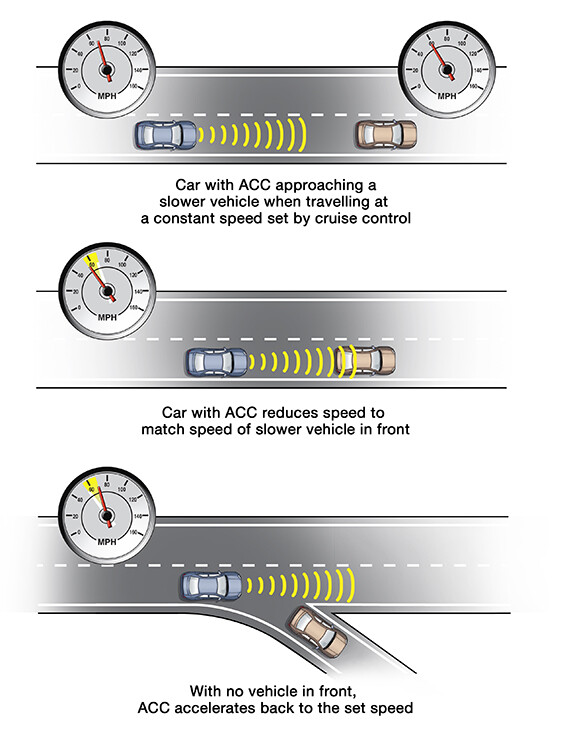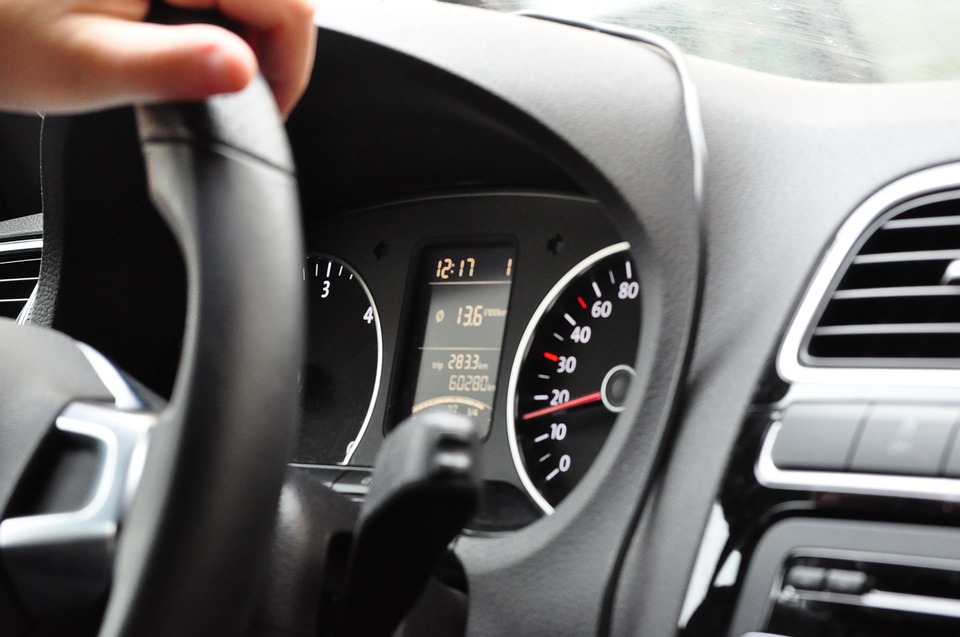A guide to adaptive cruise control RAC Drive
Table Of Content

For this reason, it's important to decide whether there are enough benefits for the technology to be worthwhile for the way you drive. Cruise control is a feature allowing the driver to set a predetermined speed, which the system’s computer maintains until the driver adjusts the speed, taps the brake, or disengages the system. In other words, once set, the cruise control system automatically controls vehicle speed, relieving the driver of that responsibility.
Back to Driver Assistance
The white Adaptive Cruise Control icon will change to green, which means the system is in use. When the ACC system detects that your car is approaching the car ahead of you, it slows down your vehicle and sounds a beep to alert you to the fact that you ought to put on the brakes. With or without ACC, it’s important to always leave more space during poor driving conditions, including inclement weather. This technology has the capacity to make you a safer driver so you’d think that would be represented in your quote. Not only do the ACC systems react to your surroundings, they also mean you don’t have to worry about stopping and starting in traffic jams as the system takes care of that for you, providing you with an extra layer of safety.
Adaptive Cruise Control Based on Safe Deep Reinforcement Learning

While ACC handles long boring highway drives, crowded city streets require an entirely new level of autonomous driving expertise. Aftermarket systems provide a taste of ACC and advanced driver assist capabilities. But overall, OEM automaker ACC integration delivers a smoother and more reliable driver experience. For example, the Hyundai Elantra SEL ($22,795 with destination fee) offers its Smart Cruise Control with Stop and Go in its optional Convenience Package ($1,900). It also includes forward collision warning with automatic emergency braking, Junction-Turning Detection, navigation, wireless phone charging, heated front seats, and more.
The Road to Fully Autonomous Driving
In traffic jams, the car will handle all the slowdowns without you having to constantly adjust your speed. When traveling on long-distance road trips, the car will help you slow down and speed up when other vehicles are going slower than your cruise control speed setting. The technology also helps you avoid hitting other people if you get distracted while driving. Adaptive cruise control is a special safety feature that enables your vehicle to control its speed and select other features some of the time. This feature lets your car slow down when necessary to avoid collisions or when your vehicle is too close to the other drivers on the road.
In essence, not only did the 1999 S-Class introduce the driver-aid technology adaptive cruise control (ACC), but it also set the cornerstone of the foundation for self-driving vehicles. By the early 1990s, Japanese carmakers were adding a form of forward collision warning to their cruise control, but it was still up to the driver to react and apply the brakes. Not until Mercedes-Benz developed its Distronic cruise control did cruise control with self-braking make its first public appearance.
If the vehicle ahead shoots ahead suddenly, your car won’t follow suit. Instead, it will stick to the speed you have previously set, unless it catches up to another car in front. To find out if your vehicle has this feature, contact your dealer or refer to your vehicle’s equipment list. Please check your Owner’s Manual for more information about features.
Adaptive cruise control (ACC) is like traditional cruise control, but smarter. ACC systems allow you to set a desired speed until your vehicle encounters slower-moving traffic. Then it will brake to maintain a set distance from the car ahead.

How Do Self-Driving Cars Work? - The Zebra
How Do Self-Driving Cars Work?.
Posted: Wed, 01 Nov 2023 07:00:00 GMT [source]
Adaptive Cruise Control calibration takes place when the camera, lidar, and radar sensors that inform your vehicle’s actions are re-aligned to improve or re-establish sensor accuracy. In this article, we will explain adaptive cruise control and how it works, provide examples of ACC features in ADAS packages, and explain the importance of adaptive cruise control calibration. An ACC system may also not work properly in certain weather conditions like heavy rain or fog, if there is mud or snow on the sensors, or if roads are slippery.
Car Sales Are Speeding Up, But Dealers Still Have Too Much Inventory
He writes strongly on consumer advice and new cars, and we consider him an asset to readers looking for guidance in buying and selling autos. As with so many automotive technologies, automakers have not agreed on a single name for adaptive cruise control and its different permutations. In cars offering “stop and go” functionality, the system is able to restart itself when the car in front starts moving again. Classic cruise control is most useful on a long, relatively straight piece of highway when there aren’t too many cars around. To choose a cruise speed, press the Set button while driving at the desired speed.
Adaptive Cruise Control: How Does It Work? - Kelley Blue Book
Adaptive Cruise Control: How Does It Work?.
Posted: Thu, 21 Jul 2022 07:00:00 GMT [source]
Once the traffic starts moving again or if there is no longer a car in the lane ahead, ACC will accelerate to resume the previous set speed. Although ACC systems may take some getting used to, our survey respondents told us they appreciated the stress relief the feature brings. ACC uses radar, laser sensors or cameras to monitor the vehicle ahead and adjust your speed accordingly to maintain a preset following distance. If the vehicle in front slows, so does your car – automatically! ACC reduces the constant manual braking and acceleration required in heavy traffic. “With adaptive cruise control, eyesight can help you stay with the flow of traffic.
You can then adjust the speed manually up or down by simply pushing the button. Once you’ve programmed your desired speed, you can instruct the ACC the distance, in seconds or yards, that you wish to maintain from the car ahead of you. Most (but not all) current forms of this ADAS use radar as their main source of information. A radar sensor mounted in the front of the vehicle is used to analyze the road ahead. It does this by emitting radio waves and measuring how long they take to return to the ACC sensor. A few internal calculations and your vehicle can tell the car’s distance and speed.
Running a car isn’t cheap, but there are some easy things you can do to keep your costs down. Get these tips and more useful driving articles sent straight to your inbox now. You should read your Owner’s Manual to learn more about the limitations of the system. If equipped, Adaptive Cruise Control may be used when towing an attached trailer that is electrically connected and within GM-approved allowable size and weight limits.
Systems with multiple sensors can practice sensor fusion to integrate the data to improve safety and/or driving experience. GPS data can inform the system of geographic features such as a freeway offramp. A camera system could notice driver behavior such as brake lights and/or a turn signal. There continues to be plenty of confusion about self-driving or autonomous systems, what they are, and how they operate. However, the major difference between adaptive cruise control and a self-driving system is, ACC is simply a component of a driverless system.
Comments
Post a Comment